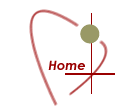Bradycardia
is a condition of the heart in which the pulse rate (heart beat)
falls to a level, which causes the patient to have symptoms of
fainting as well as easy fatigue, dizziness, etc.
A very slow pulse rate can be tolerated,so long as the amount
of blood pumped out of the left side of the heart per minute is
adequate to oxygenate the brain and the other parts of the body.
Once the heart is unable to fullfill this requirement fainting
will occur.
For example, the 24 hour EKG Holter recording of an asymptomatic
18 year old male athlete shows a slow heart rate of 30 per minute,
while he was sleeping (the parasympathetic nerve was stimulated
to cause the heart rate slowing with one junctional slowing escape
beat).
But during exercise his rate went up to 180 a minute with a normal
PR interval.No symptoms developed during long term followup (see
figure
93b).
Normal
range of heart rates in the afternoon has been reported to be
46 to 93 beats per minute for men, and 51 to 95 beats per minute
for women.
Nocturnal rates are slower, decreasing during sleep by an average
of 24 beats per minute in young adults and by 14 beats in those
over 80 years of age.
Trained
athletes are prone to bradycardia (slow pulses) with heart rates
below 40 beats per minute common at rest.
In
view of these findings, the American Heart Association current
guidelines for pacemaker implantation (a battery powered,lithium-iodine
type, electronic,pulse generating device embedded under the skin
of the chest, just below the right clavicle usually, and connected
to the right atrium and/or ventricle by a sterile wire, which
is guided through the cephalic vein) advise the following:
1. Episodes of sinus bradycardia with heart rates as low as 30
beats per minute, which cause no symptoms, are to be considered
with in the normal range.
2.Also,normal are sinus pauses (no P waves) of up to 3 seconds
(see fig
16, second EKG) and atrioventricular nodal Wenckebach block,
where the PR interval successively increases until a P wave is
finally not followed by a QRS on the EKG (see fig
17, second EKG).
-
Sinus Node Dysfunction:
a. Sinus Bradycardia
b. Sinus Arrest
c. Sinoatrial Exit Block
d. Bradycardia
- Tachycardia syndrome
-
Atrioventricular Conductive Disturbances:
a. 1st Degree Atrioventricular AV block
b. 2nd Degree AV block Mobitz type I
c. 2nd Degree AV block Mobitz type II
d. 2nd Degree High Grade AV Block
e. 3rd Degree AV Block
Causes
of Bradycardia (see table )
Bradycardia
Evaluation
Bradycardia
Managment


